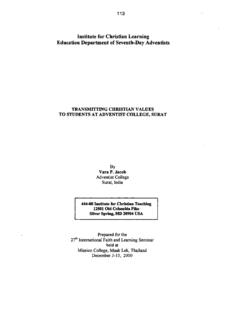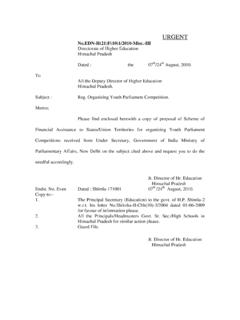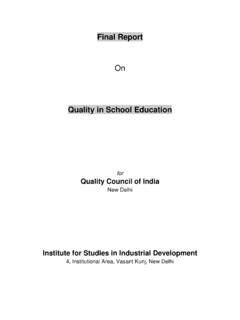Transcription of Dreams and Realities - ERIC
1 Dreams and Realities :Developing Countries and the English LanguageEdited by Hywel ColemanPaper 4 Language policy in education and the role of English in india : From library language to language of empowerment by Ramanujam planning and implementation 4 Language policy in education and the role of English in india : From library language to language of empowermentRamanujam MeganathanIntroductionThroughout india , there is an extraordinary belief, among almost all castes and classes, in both rural and urban areas, in the transformative power of English. English is seen not just as a useful skill, but as a symbol of a better life, a pathway out of poverty and oppression. Aspiration of such magnitude is a heavy burden for any language, and for those who have responsibility for teaching it, to bear.
2 The challenges of providing universal access to English are significant, and many are bound to feel frustrated at the speed of progress. But we cannot ignore the way that the English language has emerged as a powerful agent for change in india . (Graddol 2010:120)This chapter explores language policy-making processes in the Indian context, implementation issues and the place and role of English in school education. Language in education policy derives from the Indian Constitution which guarantees linguistic rights to all citizens; most importantly, members of minority groups (both religious and linguistic) are granted a special right to be educated in their mother tongue. Despite this consensus, there have been numerous political and educational controversies regarding implementation of these constitutional national language policy (or strategy) for school education, the three-language formula recommended by the National Commission on Education 1964 1966, was incorporated into the national education policies of 1968 and 1986.
3 Accommodating at least three-languages in school education has been seen as a convenient strategy, but concerns have also been expressed from various quarters about its unsatisfactory implementation. india s pluralism is reflected in its linguistic diversity. According to the 1971 census, the country has 1,652 languages belonging to five different language families: Indo-2 | Policy planning and implementation Policy planning and implementation | 3 Aryan, Dravidian, Austro-Asiatic, Tibeto-Burmese and Semito-Hamitic (GOI 1971). The Indian constitution identifies 22 recognised languages . About 87 languages are used in print media, 71 languages are used on radio and the administration of the country is conducted in 15 languages.
4 According to Rao (2008), two decades ago the number of languages used as media of instruction was about 60 but by the time Rao s study was carried out the number had dropped to 47. (As we will see below, it appears that this number has now fallen further still.) English formerly perceived as a library language and the language of higher education is now in demand by every quarter as a means of progress and the key to a better life. As Graddol points out, the language which was a key part of the mechanism of exclusion because of its very unequal distribution in society is now seen as a means of inclusion (Graddol 2010:120). The English language in india today is both an admired and a hated phenomenon.
5 On the one hand, there is an increasing demand for the language which is associated with progress and development, while on the other the language is perceived as a killer of native or indigenous languages. The demand for English emerges from many factors, as recognised by the position paper on the teaching of English produced by the National Council of Educational Research and Training (NCERT 2006) in connection with the National Curriculum Framework 2005 (NCERT 2005):English in india today is a symbol of people s aspirations for quality in education and fuller participation in national and international life .. The level of introduction of English has now become a matter of political response to people s aspirations, rendering almost irrelevant an academic debate on the merits of a very early introduction.
6 (NCERT 2006:1)However, the disparity in the quality of English language education experienced by children further intensifies the already existing divide between English language-rich and English language-poor children. The present condition of English language teaching in the varied contexts of india is summed up in the following manner:1. TP EE ( English medium private/government aided elite schools): Proficient teachers; varying degrees of English in the environment, including as a home or first TP EE ( New English medium; private schools, many of which use both English and other Indian languages): Teachers with limited proficiency; children with little or no background in English; parents aspire to upward mobility through TP EE ( Government-aided regional medium schools): Schools with a tradition of English education along with regional languages, established by educational societies, with children from a variety of backgrounds.
7 4. TP EE ( Government regional medium schools run by district and municipal education authorities): They enrol the largest number of elementary school children in rural india . They are also the only choice for the urban poor (who, however, have some options of access to English in the environment). Their teacher may be the least proficient in English in these four types of school . Policy planning and implementation | 3TP = Teachers English language proficiency; EE = English language environment (Kurrien 2005 quoted in NCERT 2006:9)The rest of this chapter consists of seven sections, beginning with a brief historical overview of the three-language policy. The next section discusses the number of languages taught in Indian schools.
8 This is followed by details of languages taught as first, second and third languages. The following section looks at the languages used as media of instruction. There is then a section focusing on the introduction of the second and third languages. The penultimate section then summarises all the findings reported here which relate to English and the chapter ends with a policy in school education: The three-language formulaLanguage planning for school education in india can be seen more as a question of status planning rather than corpus or acquisition planning. The language policy which emerged as a political consensus in the formative years of independence is also an illustration of democratic processes in the Asian context.
9 The three-language formula emerged as a policy or a strategy after a quarter of a century of debate and deliberations from political and academic perspectives by educational advisory bodies and politicians representing national and regional interests. The Central Advisory Board on Education (CABE), the oldest statutory body on education in india , initiated the discussion on languages in school education in the 1940s and this continued to be a major concern in their discussions until 1960. CABE identified five major issues which required attention:1. The number of languages to be taught at various levels of school education2. The introduction of second and third languages3. The place and role of English4.
10 The place and role of Hindi5. The teaching of Sanskrit and minor language(s) in school . The Board devised the three-language formula in its 23rd meeting held in 1956 with a view to removing inequalities among the languages of india . It recommended that three-languages should be taught in the Hindi as well as non-Hindi-speaking areas of the country at the middle and high school stages and suggested the following two possible formulae:1. (a) i. Mother tongue or ii. Regional language or iii. A composite course of mother tongue and a regional language or iv. A composite course of mother tongue and a classical language or v. A composite course of regional language or a classical language, (b) Hindi or English (c) A modern Indian language or a modern European language provided it has not already been taken under (a) and (b) | Policy planning and implementation Policy planning and implementation | 52.



















